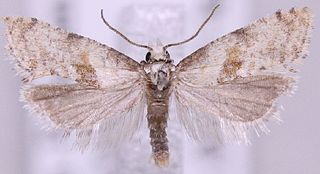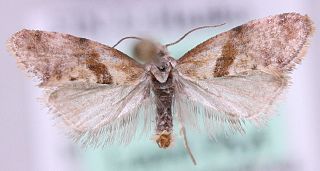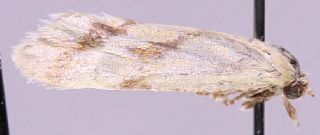
The Cochylini are a tribe of tortrix moths. It used to be classified as the subfamily Cochylinae.

The Zeiraphera griseana, the larch tortrix, is a moth of the family Tortricidae.

Cochylis is a genus of moths belonging to the subfamily Tortricinae of the family Tortricidae.

Phalonidia contractana is a moth of the family Tortricidae. It is found in southern Europe, Dalmatia, Macedonia, Hungary, Romania, Bulgaria, Greece, Ukraine, southern Russia (Sarepta), Uralsk, Turkey, Kuldscha, Afghanistan, Kashmir, Lebanon, China, Iran, Pakistan and Kyrgyzstan.

Cochylidia is a genus of moths belonging to the family Tortricidae.

Cochylidia rupicola, the chalk-cliff tortrix or conch, is a moth of the family Tortricidae.

Isodemis serpentinana is a moth of the family Tortricidae first described by Francis Walker in 1863. It is known from China, India, Indonesia, New Guinea, the Philippines, Sri Lanka and Thailand.

Cochylidia heydeniana, the blue-fleabane conch, is a moth of the family Tortricidae. It was described by Gottlieb August Wilhelm Herrich-Schäffer in 1851. It is found from most of Europe to China (Xinjiang), Mongolia, Korea, Russia and Japan. The habitat consists of dry pastures, wasteland and sand dunes.

Cochylidia implicitana, the chamomile conch, is a moth of the family Tortricidae. It was described by Wocke in 1856. It is found in most of Europe, except Ireland and most of the Balkan Peninsula. Outside of Europe, it is found in Morocco, the Alatau mountains in Central Asia, Iran and China (Xinjiang). The habitat consists of waste ground and verges.

Cochylidia richteriana is a moth of the family Tortricidae. It was described by Josef Emanuel Fischer von Röslerstamm in 1837. It is found from central and northern Europe to Mongolia, China, the Russian Far East, Korea and Japan.

Cochylidia subroseana, the dingy roseate conch, is a moth of the family Tortricidae. It was described by Adrian Hardy Haworth in 1811. It is found from most of Europe to China, Russia, Korea and Japan. It has also been recorded from North America.

Aethes fennicana is a species of moth of the family Tortricidae. It is found in northern and central Europe, Iran and China (Xinjiang).
Aethes subcitreoflava is a species of moth of the family Tortricidae. It is found in China.
Cochylidia altivaga is a species of moth of the family Tortricidae. It is found in China and Nepal.
Cochylidia contumescens is a species of moth of the family Tortricidae. It was described by Edward Meyrick in 1931. It is found in China, Korea, Japan and Russia.
Cochylidia liui is a species of moth of the family Tortricidae. It is found in Guizhou, China.
Cochylidia oblonga is a species of moth of the family Tortricidae. It is found in China.

Cochylidia moguntiana is a species of moth of the family Tortricidae. It is found in Spain, Sweden, Denmark, Germany, Poland, Austria, Italy, the Czech Republic, Slovakia, Croatia, Hungary, Romania, Estonia, Latvia, Lithuania, Russia, Afghanistan, Kyrgyzstan, northern Pakistan, Iran, China and Korea.

Eucosma cana, the hoary bell, is a species of moth of the family Tortricidae.
Nicholas Sergeevich Obraztsov (1906–1966) was a Russian-American scholar, entomologist, and leading specialist of the tortricoid microlepidoptera.













